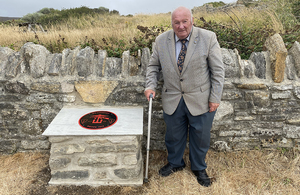Role of Defence Training Estate recognised in commando memorial unveiling
A memorial plaque has been unveiled on the Defence Training Estate in Lulworth, to recognise the bravery of the men of 4 (Army) Commando, who carried out a daring raid in Dieppe which paved the way for the success of the D-Day landings.

Naval historian and former Chairman of the Weymouth and Portland Residents Association, Alvin Hopper, alongside the newly unveiled memorial plaque. Crown Copyright / MOD 2022.
The plaque has been installed at Worbarrow Bay, which is part of the Defence Infrastructure Organisation (DIO)-managed military training estate. The land provided a vital training area for the commando unit, which carried out the ‘splinter’ operation, known as Operation Cauldron, to immobilise German heavy artillery that posed a threat to the beach landing areas in France during WW2.
Following specialist training in Scotland, 4 Commando returned to Worbarrow to carry out crucial cliff scaling exercises in preparation for their task. On 19 August 1942, the commandos launched their raid alongside a Canadian unit, which came ashore under fire from mortars and machine guns. There were 5,000 casualties that day.
There is already a commemorative plaque at West Bay to remember the Canadian troops involved, but up until now, there has been no memorial to acknowledge the role of 4 Commando. Further to the memorial on the Defence Training Estate, a duplicate memorial, unveiled on the same day, will sit in the Weymouth memorial garden, which is used for local remembrance services.
DIO Regional Commander Colonel Tim Jalland, who unveiled the Worbarrow Bay memorial, said:
These Ranges, one of only two sites available for Armoured Fighting Vehicle Fire and Movement Exercises, remain one of the busiest Range complexes in the UK. In addition to their operational importance, the Ranges are located in a beautiful, historically significant and environmentally diverse part of the landscape, which the MOD takes pride in sustaining and maintaining for the Armed Forces and general public alike.
Naval historian and former Chairman of the Weymouth and Portland Residents Association, Alvin Hopper, is the inspiration behind the plaque, which he said will serve as an important reminder of the coastline’s history as well as acknowledge the vital role played by the unit.
Mr Hopper said:
We should educate the younger people about their history. They don’t get taught this at school, there’s a lot that’s missed out, especially the local history. Lots of visitors to the area will now be aware of the history. Hopefully, when they see the plaque, they will go and look it up. With the use of modern-day technology, they can get on-the-spot information.
In his naval role, Mr Hopper served in the mine warfare service, which became the Royal Naval Auxiliary Service, and he knows the Dorset coastline very well. He added that military training areas are as vital for troops today as they were then.
He said:
To have somewhere to train is vitally important. These dedicated training areas give our forces the edge, somewhere to hone their skills. Worbarrow Bay was crucial for 4 Commando because the terrain almost identically matched the terrain they would be facing on the raid.
The duplicate memorial plaque in Weymouth was unveiled by the Mayor of Weymouth, Councillor Ann Weaving and Her Majesty’s Lord-Lieutenant of Dorset Angus Campbell.
The Lulworth Ranges have provided armoured and dismounted live fire and manoeuvre training facilities for the UK Armed Forces since WW1. The land is part of the Defence Training Estate, which covers around one per cent of land in the UK and plays a vital role in preparing UK and visiting troops for operations across the globe. The UK training area covers 157,000 hectares and includes 9,000 buildings, 21m trees, 3,500km of tracks and more than 70 Sites of Special Scientific Interest.
The estate supports training scenarios that include practising fighting in built-up areas, firing artillery, amphibious landings and assaults, driving tanks and firing from naval vessels and aircraft.